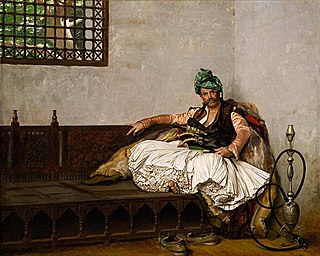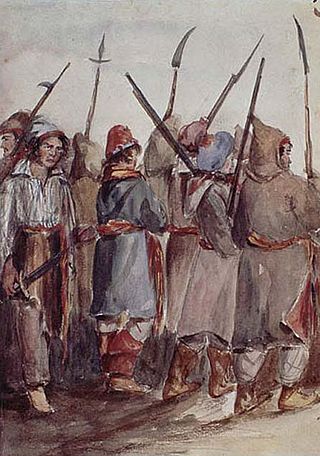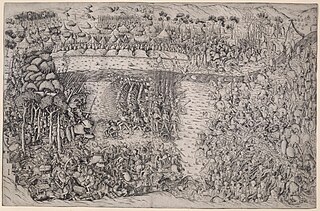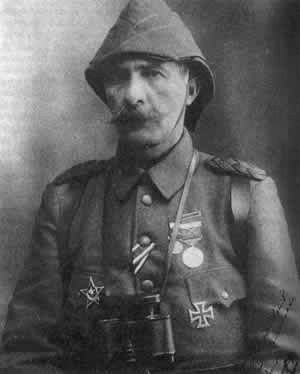
Mehmed II, commonly known as Mehmed the Conqueror, was twice the sultan of the Ottoman Empire from August 1444 to September 1446 and then later from February 1451 to May 1481.

The Peloponnese, Peloponnesus or Morea is a peninsula and geographic region in Southern Greece, and the southernmost region of the Balkans. It is connected to the central part of the country by the Isthmus of Corinth land bridge which separates the Gulf of Corinth from the Saronic Gulf. From the late Middle Ages until the 19th century, the peninsula was known as the Morea, a name still in colloquial use in its demotic form.

A bashi-bazouk was an irregular soldier of the Ottoman army, raised in times of war. The army chiefly enlisted Albanians and Circassians as bashi-bazouks, but recruits came from all ethnic groups of the Ottoman Empire, including slaves from Europe or Africa. Bashi-bazouks had a reputation for being undisciplined and brutal, notorious for looting and preying on civilians as a result of a lack of regulation and of the expectation that they would support themselves off the land.

The First Balkan War lasted from October 1912 to May 1913 and involved actions of the Balkan League against the Ottoman Empire. The Balkan states' combined armies overcame the initially numerically inferior and strategically disadvantaged Ottoman armies, achieving rapid success.

The military of the Ottoman Empire was the armed forces of the Ottoman Empire.

The Second Battle of Kosovo was a land battle between a Hungarian-led Crusader army and the Ottoman Empire at Kosovo field that took place from 17–20 October 1448. It was the culmination of a Hungarian offensive to avenge the defeat at Varna four years earlier. In the three-day battle the Ottoman army under the command of Sultan Murad II defeated the Crusader army of regent John Hunyadi.

Irregular military is any non-standard military component that is distinct from a country's national armed forces. Being defined by exclusion, there is significant variance in what comes under the term. It can refer to the type of military organization, or to the type of tactics used. An irregular military organization is one which is not part of the regular army organization. Without standard military unit organization, various more general names are often used; such organizations may be called a troop, group, unit, column, band, or force. Irregulars are soldiers or warriors that are members of these organizations, or are members of special military units that employ irregular military tactics. This also applies to irregular infantry and irregular cavalry units.

The Stratioti or Stradioti were mercenary units from the Balkans recruited mainly by states of Southern Europe and Central Europe from the 15th century until the middle of the 18th century. They pioneered light cavalry tactics in European armies in the early modern era.

The Byzantine–Ottoman wars were a series of decisive conflicts between the Byzantine Greeks and Ottoman Turks and their allies that led to the final destruction of the Byzantine Empire and the rise of the Ottoman Empire. The Byzantines, already having been in a weak state even before the partitioning of their Empire following the 4th Crusade, failed to recover fully under the rule of the Palaiologos dynasty. Thus, the Byzantines faced increasingly disastrous defeats at the hands of the Ottomans. Ultimately, they lost Constantinople in 1453, formally ending the conflicts.

The Morean war, also known as the Sixth Ottoman–Venetian War, was fought between 1684–1699 as part of the wider conflict known as the "Great Turkish War", between the Republic of Venice and the Ottoman Empire. Military operations ranged from Dalmatia to the Aegean Sea, but the war's major campaign was the Venetian conquest of the Morea (Peloponnese) peninsula in southern Greece. On the Venetian side, the war was fought to avenge the loss of Crete in the Cretan War (1645–1669). It happened while the Ottomans were entangled in their northern struggle against the Habsburgs – beginning with the failed Ottoman attempt to conquer Vienna and ending with the Habsburgs gaining Buda and the whole of Hungary, leaving the Ottoman Empire unable to concentrate its forces against the Venetians. As such, the Morean War was the only Ottoman–Venetian conflict from which Venice emerged victorious, gaining significant territory. Venice's expansionist revival would be short-lived, as its gains would be reversed by the Ottomans in 1718.

The Palaiologan army refers to the military forces of the Byzantine Empire under the rule of the Palaiologos dynasty, from the late 13th century to its final collapse in the mid-15th century. The army was a direct continuation of the forces of the Empire of Nicaea, which itself was a fractured component of the formidable Komnenian army of the 12th century. Under the first Palaiologan emperor, Michael VIII, the army's role took an increasingly offensive role whilst the naval forces of the empire, weakened since the days of Andronikos I Komnenos, were boosted to include thousands of skilled sailors and some 80 ships. Due to the lack of land to support the army, the empire required the use of large numbers of mercenaries.

The First Ottoman–Venetian War was fought between the Republic of Venice with its allies and the Ottoman Empire from 1463 to 1479. Fought shortly after the capture of Constantinople and the remnants of the Byzantine Empire by the Ottomans, it resulted in the loss of several Venetian holdings in Albania and Greece, most importantly the island of Negroponte (Euboea), which had been a Venetian protectorate for centuries. The war also saw the rapid expansion of the Ottoman navy, which became able to challenge the Venetians and the Knights Hospitaller for supremacy in the Aegean Sea. In the closing years of the war, however, the Republic managed to recoup its losses by the de facto acquisition of the Crusader Kingdom of Cyprus.

The Ottoman-Mamluk war took place from 1485 to 1491, when the Ottoman Empire invaded the Mamluk Sultanate territories of Anatolia and Syria. This war was an essential event in the Ottoman struggle for the domination of the Middle-East. After multiple encounters, the war ended in a stalemate and a peace treaty was signed in 1491, restoring the status quo ante bellum. It lasted until the Ottomans and the Mamluks again went to war in 1516–17; in that war the Ottomans defeated and conquered the Mamluks.

Mehmet Esat Bülkat was an Ottoman Army officer who fought during the First Balkan War, where he led the Yanya Corps, and in World War I, where he served as a senior commander in the Gallipoli campaign. Prior to the 1934 Surname Law, he was known as Mehmed Esad Pasha.
Voynuks were members of the privileged Ottoman military social class established in the 1370s or the 1380s. Voynuks were tax-exempt non-Muslim, usually Slavic, and also non-Slavic Vlach Ottoman subjects from the Balkans, particularly from the regions of southern Serbia, Macedonia, Thessaly, Bulgaria and Albania and much less in Bosnia and around the Danube–Sava region. Voynuks belonged to the Sanjak of Voynuk which was not a territorial unit like other sanjaks but a separate organisational unit of the Ottoman Empire.
Yaya or Piyade were infantry military units of the Ottoman Empire and some other medieval Anatolian beyliks. Many of them were of Christian origin.

The Agha of the Janissaries or Janissary Agha was a top Ottoman military official and courtier, and the commander of the Janissary corps. Apart from the commander-general of the entire corps, the title of "Agha of the Janissaries" was also borne by the commander of a provincial garrison of Janissaries.
Derbendcis or Derbentler were the most important and largest Ottoman military auxiliary constabulary units usually responsible for guarding important roads, bridges, fords or mountain passes. Usually, the population of an entire village near some important pass would be assigned with derbendci status in exchange for tax exemptions.
The martolos was an internal security force of the Ottoman Empire in the Balkans (Rumelia), mostly active between the 15th to 17th centuries. It initially constituted out of the local mostly Christian populations, but over time members converted into Islam. For their military service, they were given privileged status, in relation to the Rayah. Their commanders were predominantly Muslim.
Kapıkulu was the collective name for the household division of the Ottoman Sultans. They included the Janissary infantry corps as well as the Six Divisions of Cavalry. Unlike provincial levies such as the timariots and irregular forces (levend), the kapıkulu were professional, standing troops, mostly drawn through the devshirme system. They formed the backbone of the military of the Ottoman Empire during its "classical period", from the 15th century until the Auspicious Incident of 15 June 1826 that lead to the abolition of the kapıkulu during the Tanzimat.
















